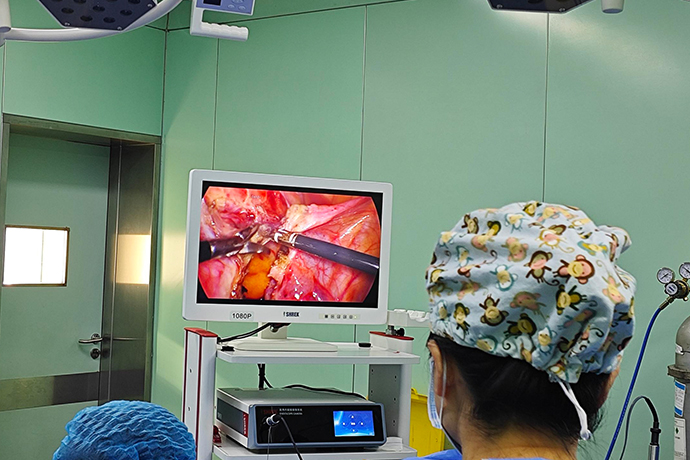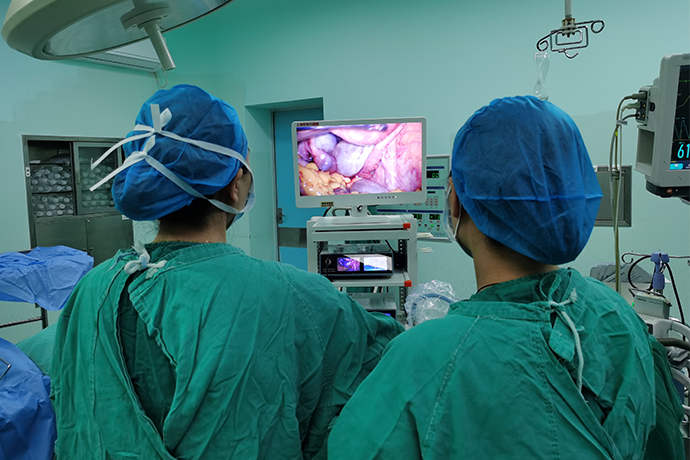[Gynecological laparoscopy] 4K laparoscopy for adenomyosis
Release time: 19 Sep 2023 Author:Shrek
If your menstrual cramps are getting worse
If you have a heavy period and have blood clots
If you find anemia and don’t know the cause
If you have been trying to get pregnant for 1 year and still haven’t gotten what you wanted
If your uterus is enlarged on ultrasound
...
You may have adenomyosis

Uterine adenomyosis (UAM) is a common clinical disease and frequently-occurring disease in obstetrics and gynecology. It refers to the invasion of endometrial glands and stroma into the basal layer of the uterus, forming localized and diffuse lesions. Hysterectomy is a common method to treat adenomyosis, but it has great limitations and is often unacceptable to patients who require uterine preservation or fertility preservation. With the rapid development of minimally invasive technology, laparoscopic adenomyosis lesion resection is widely used to meet the needs of patients to preserve their fertility function.
Adenomyosis is a common disease in women of childbearing age. It mostly occurs in multiparous women aged 30 to 50 years. Its causes and mechanisms are complex and may be related to the proliferation of endometrial basal cells and compensatory hyperplasia of surrounding basal cells. Clinically It can manifest as increased menstrual flow, dysmenorrhea, infertility, etc., which can seriously affect the patient's normal life and work. There are many methods for clinical treatment of adenomyosis, such as drugs, surgery, etc. The efficacy of drug treatment is extremely unsatisfactory, with severe side effects and high recurrence rate.
The efficacy of traditional hysterectomy is acceptable, but it requires removal of the uterus, loss of fertility, large trauma, and slow recovery. It is not well accepted among younger patients.
With the rapid development of medical technology and the continuous improvement of laparoscopic technology, 4k ultra-high-definition laparoscopy is widely used in the treatment of adenomyosis, creating a new minimally invasive treatment method that can avoid the high recurrence rate caused by drug treatment, and Laparotomy surgery brings disadvantages such as large trauma and slow recovery, but it meets women's requirements for preserving the uterus and has a high degree of acceptance.
Laparoscopic adenomyosis reduction surgery: due to its advantages of less trauma, fast recovery, low postoperative morbidity, and low incidence of long-term pelvic and abdominal adhesions and other diseases, it is increasingly used in clinical practice. The biggest challenge of debulking surgery is the long-term uterine cavity volume reduction and scar tissue formation, so it is for patients who still want to have children. It is still necessary to be cautious when choosing laparoscopic debulking surgery, and laparotomy is appropriate when necessary.
So, which uterine fibroids are suitable for laparoscopic surgery, and which ones are not? For top laparoscopy experts, there are almost no fibroids that cannot be removed through laparoscopy, but there are not many such people after all. Most patients still deal with ordinary gynecologists, so when choosing a uterine fibroid removal surgery, you need to consider the following conditions:
① Is the fibroid one (single fibroid) or multiple (multiple fibroids)? Relatively speaking, single fibroids are more suitable for removal by laparoscopy, while multiple fibroids, especially when there are many uterine fibroids, and each one is large, it is more difficult to remove them by laparoscopy. The main reason is not that it is difficult to remove the tumor, but that it is difficult to suture the wound on the surface of the uterus through laparoscopy after removal, which will lead to more bleeding and even shock.
② Are they intramural fibroids, subserosal fibroids, or submucosal fibroids? Comparing the uterus to an independent house, if most or all of the fibroids are located on the inner wall of the house, they are called submucosal fibroids; if most or all of the fibroids are located on the outer walls of the house, they are called subserosal fibroids. If the fibroid is located in the middle of the wall, it is called an intramural fibroid. From a laparoscopic perspective, what can be seen is the outer surface of the uterus. Therefore, subserosal fibroids are the easiest to remove laparoscopically, followed by intramural fibroids of a certain size (too small to be seen in the middle of the wall). Small submucosal fibroids are difficult to remove laparoscopically. , the latter can be removed using another minimally invasive technique, namely hysteroscopy.
③ Are the fibroids located on the top (fundus), front, lower, or back wall of the uterus? Laparoscopic surgery is easier for fibroids located in the fundus and anterior wall (corresponding to the roof and front). For fibroids on the lower segment and posterior wall (equivalent to the foundation and posterior wall), there is no difficulty in removing the tumor through laparoscopy, but it is also more difficult to suture.
④ Does the patient need to have children after surgery? If childbearing is desired, laparoscopic removal of large or multiple uterine fibroids requires trade-offs. First of all, laparoscopic surgery has the highest technical requirements for suturing, and overall suturing is not as strong as open surgery. If you become pregnant after myomectomy, as the uterus continues to grow, the suture will become a weak point, and the risk of uterine rupture will be greater. Secondly, women who become pregnant after myomectomy generally require a cesarean section, which requires an incision of more than 10 cm in the abdomen. The result of laparoscopic surgery that leaves no scars on the abdomen will be completely destroyed. Therefore, for women who need to have children after surgery and have multiple uterine fibroids, laparotomy may be safer, and it is not worthwhile to pursue a temporary absence of scars on the abdomen.
⑤ Which one is cleaner to remove fibroids, laparotomy or laparoscopy? Generally speaking, one of the weaknesses of laparoscopy is that the doctor lacks direct touch during the operation, because the doctor holds one end of the half-meter-long surgical instrument, which is equivalent to a blind cane. During laparotomy, doctors can detect small fibroids hidden in the uterine muscle wall by touch with their hands; however, during laparoscopic surgery, it is difficult to find such small fibroids.
During laparoscopy, the uterus can be isolated from surrounding tissues or organs such as the bladder, abdominal wall, intestines, etc. with gauze or instruments. At the same time, the entire needle path can be monitored in real time. The needle path is monitored outside the uterus using a laparoscope. Transvaginal ultrasound is used to monitor and guide the penetration of lesions in real time, and laparoscopy is used to control the safe range of the more dangerous parts of the uterus, achieving the "combination of two swords" to accurately locate and ablate lesions.

- Recommended news
- 【General Surgery Laparoscopy】Cholecystectomy
- Surgery Steps of Hysteroscopy for Intrauterine Adhesion
- [Gynecological Hysteroscopy] Techniques for Preventing and Treating Complications of Hysteroscopic Surgery
- [Gynecological Hysteroscopy] Hysteroscopic Adhesiolysis
- [Gynecological Hysteroscopy] IUD Removal under Hysteroscopy